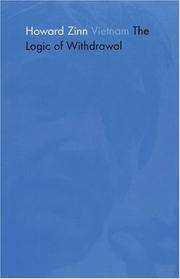

Stock Photo: Cover May Be Different
Vietnam: The Logic of Withdrawal.
by Howard Zinn
- Used
- Paperback
- first
- Condition
- See description
- ISBN 10
- 089608681X
- ISBN 13
- 9780896086814
- Seller
-
Oregon City, Oregon, United States
Payment Methods Accepted
About This Item
Cambridge, MA South End Press, 2002. Paperback Reprint Edition [2002]; First Printing Thus. Fine in Wraps: binding square and secure; text clean. Virtually 'As New'. NOT a Remainder, Book-Club, or Ex-Library. 8vo. 131pp. 8vo. 150 pages. Radical 60s Series, Book 3. Reprint Edition [2002]; First Printing Thus. Originally published in various journals and then by Beacon in 1967. Trade Paperback. Zinn’s compelling case against the Vietnam War, now with a new introduction. Of the many books that challenged the Vietnam War, Howard Zinn’s stands out as one of the best—and most influential. It helped sparked national debate on the war. It includes a powerful speech written by Zinn that President Johnson should have given to lay out the case for ending the war. Includes a new introduction by the author.The Vietnamese puppets of the French running the South knew that Ho Chi Minh would win any free and fair election so they would repeatedly refuse North Vietnamese requests to hold the promised elections that were supposed to reunify the country as called for in the 1954 Geneva accords. Zinn quotes Bernard Fall, the French right wing military analyst much respected by hawkish American planners, as saying that from 1957 to 1960, the U.S. installed South Vietnamese dictator Ngo Dinh Diem. Zinn notes that guerilla activity started in the late 50's, by the reactivated units of the Viet Minh, after Diem's stolen elections, torture,"manhunts" etc. He quotes experts on Vietnam that the National Liberation Front ("Viet Cong") was created early in 1960, months before Hanoi authorized its creation, solely on the initiative of Southerners resisting U.S. backed terror. He observes the Americans already had a couple thousand military "advisors" in the South in violation of the Geneva accords long before the US State Department would claim "infiltration" and "aggression" from the North. Zinn quotes Senate Majority leader Mike Mansfield's committee report that in January 1966 there were 14,000 North Vietnamese troops in the 230,000 NLF force in the South. At the same time there were 170,000 American troops; other foreign troops included 21,000 from South Korea. So the Americans and allied occupying forces infinitely outnumbered the North Vietnamese who were, of course, fighting in "South" Vietnam, which was truly a part of their own country. The Mansfield report stated that from 1962 to 1965, 14,000 North Vietnamese "infiltrated" into the South but during the same time 100,000 persons in the South joined the NLF, the only force in South Vietnam addressing the needs of the peasant masses. In 1965, 100,000 deserted from the ARVN. He notes that in 1964 the NLF made one of its many peace offers at this point that entailed allowing it to participate as a political party in a South Vietnam w/o American occupation and military aid to the oligarchy (a "neutralist" state). He quotes Neil Sheehan and Charles Mohr of the New York Times as saying that the NLF represented true social change for better or worse against the reactionary South Vietnamese oligarchy. He quotes a French foreign correspondent as observing that when what would become the NLF began assassinating South Vietnamese government officials in 1959-60, the peasants apparently supported these actions against their oppressors. Zinn observes that the NLF committed atrocities but had a long way to go to catch the Americans in this regard.
He writes that communism has inspired activists in deeply impoverished capitalist countries, independent of any Russian or Chinese meddling, and they have adapted it to their local needs. He might have added that what the U.S. has smeared as communism in the third world is often a mild form of socialism (as in Guatemala in 1954) that cuts slightly into the profits of multinational corporations and so was overthrown by the U.S. or forced to turn to the Russians. He goes over some of the reports of U.S. atrocities in the mainstream press. In November 1965, Neil Sheehan reported several dozen hamlets completely destroyed or heavily damaged by U.S. and the ARVN (South Vietnamese army) in order to root out the supposed NLF presence in them. Sheehan reported South Vietnamese government figures that 184 civilians were killed in the five hamlets of Duchai during this attack but the figure might have been as high 600. He reported that each month about 600 to 1000 civilians were being brought to the provincial hospital, injured by American weaponry. Sheehan reported in February 1966 that U.S. napalm and bombs had destroyed 1000 peasant homes in three hamlets and a hundred civilians were killed in the village of Tamquan. The Honolulu Advertiser reported a hundred civilians killed or wounded near a Mekong Delta hamlet. Charles Mohr, reporting the case of an old woman who could no longer close her eyes and lost her arms and two of her children all because of U.S. napalm, stated "Few Americans appreciate what their nation is doing to South Vietnam with airpower." Civilians were "dying everyday in South Vietnam." Zinn quotes former Green Beret Donald Duncan as saying that he and his fellows regularly used torture against Vietnamese. He notes how in Laos the U.S. supported a right wing military coup in 1958 as the leftist Pathet Lao were about to win an election there. The U.S. would subvert in the next few years a neutralist government that allowed the Pathet Lao to be politically active. The U.S. backed military alliance SEATO insisted that the Pathet Lao were not commie stooges. This book was published in 1967. The U.S. after it destroyed the country, in 1975, placed an embargo on Vietnam that threw it into the arms of the Russians and maintained brutal conditions in the country.
Reviews
(Log in or Create an Account first!)
Details
- Seller
- Black Cat Hill Books
(US)
- Seller's Inventory #
- 44696
- Title
- Vietnam: The Logic of Withdrawal.
- Author
- Howard Zinn
- Format/Binding
- Paperback
- Book Condition
- Used
- Quantity Available
- 1
- Edition
- Reprint Edition [2002]; First Printing Thus.
- ISBN 10
- 089608681X
- ISBN 13
- 9780896086814
- Publisher
- South End Press,
- Place of Publication
- Cambridge, MA
- Date Published
- 2002.
- Bookseller catalogs
- Vietnam War; Politics; Political History; Political Thought; Anti-Authoritarian;
Terms of Sale
Black Cat Hill Books
Default shipping charges provided at the time of sale will hold unless the actual cost of shipping is significantly more - or less -t han the default shipping charge quoted. In such cases we will contact you with alternative charges; we will arrive at these charges by the following method: actual United States Postal Service (or UPS) shipping charges + $2.00 handling charge. We guarantee the accuracy of our descriptions and the quality of our packaging. Books we ship may be returned for any reason. If you are not satisfied, notify us via email, and return the book. If we are satisfied that we have provided an inaccurate description, we will refund your return shipping charges, at USPS Media Mail rates. All prices are net to all. Please let us know if we can be of further assistance in expediting your order. Thanks from the folks on Black Cat Hill.
About the Seller
Black Cat Hill Books
Biblio member since 2004
Oregon City, Oregon
About Black Cat Hill Books
Black Cat Hill Books is an Internet-only bookseller.
Glossary
Some terminology that may be used in this description includes:
- Fair
- is a worn book that has complete text pages (including those with maps or plates) but may lack endpapers, half-title, etc....
- Remainder
- Book(s) which are sold at a very deep discount to alleviate publisher overstock. Often, though not always, they have a remainder...
- New
- A new book is a book previously not circulated to a buyer. Although a new book is typically free of any faults or defects, "new"...
- Fine
- A book in fine condition exhibits no flaws. A fine condition book closely approaches As New condition, but may lack the...
- Reprint
- Any printing of a book which follows the original edition. By definition, a reprint is not a first edition.
- Trade Paperback
- Used to indicate any paperback book that is larger than a mass-market paperback and is often more similar in size to a hardcover...

